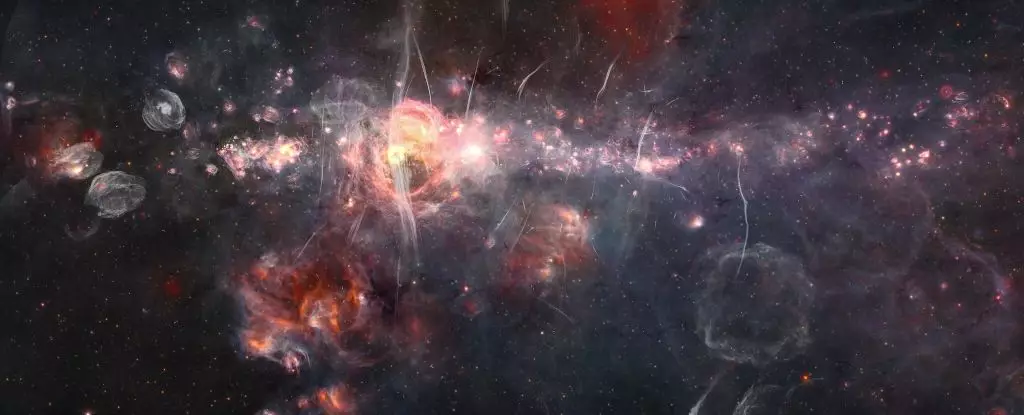Deep within the Milky Way lies an enigma that has captured the imagination of astronomers and physicists alike: the supermassive black hole known as Sagittarius A*. Contrary to its fearful reputation, the immediate vicinity of this cosmic giant is anything but serene. Recent observations have revealed a complex and dynamic environment rife with extraordinary phenomena, including the detection of an unprecedented cosmic accelerator, referred to as a PeVatron. This discovery opens a new chapter in our understanding of extreme astrophysical processes occurring at the center of our galaxy.
The High-Altitude Water Cherenkov (HAWC) observatory, perched high in the mountains of Mexico, has pioneered this exciting research. Over seven years, HAWC has amassed an impressive dataset, identifying 98 gamma-ray events emanating from a specific point in the Milky Way, dubbed HAWC J1746-2856. The energy levels of these emissions exceed 100 teraelectronvolts (TeV), marking them as some of the highest-energy gamma rays ever cataloged. Pat Harding, a prominent physicist at Los Alamos National Laboratory, expresses awe at these findings, noting that they provide a glimpse into energy levels previously unseen in our galaxy.
The significance of this research is profound. It confirms the existence of a PeVatron situated in a region known as the Galactic Center Ridge. PeVatrons are cosmic particle accelerators that can significantly boost the energy of cosmic rays, which mainly consist of charged protons and atomic nuclei. This acceleration can expel particles to extremely high energy levels, influencing the overall cosmic ray population and offering critical insights into the dynamic processes occurring near supermassive black holes.
Understanding PeVatrons requires us to delve into their mechanics. These formidable accelerators arise in environments like supernova remnants and the surroundings of massive stars or black holes. As cosmic rays interact with the gravitational and magnetic fields present in these locales, they can gain energy and reach teravolt levels. However, locating and identifying these accelerators is a complex task, primarily because such high-energy processes tend to be rare across the vastness of our galaxy.
Harding articulates a key challenge: many phenomena that create cosmic rays occur on scales that do not neatly align with the size of the Milky Way. For instance, the merger of black holes is a cataclysmic event that typically happens outside our galaxy’s confines. Thus, the very existence of a PeVatron in our own backyard presents an intriguing paradox.
Gamma rays, the most energetic form of electromagnetic radiation, behave differently than other light. They struggle to traverse Earth’s atmosphere, meaning direct observation at such high energies is impossible. Instead, gamma rays interact with atmospheric particles, leading to cascading showers of lower-energy particles. HAWC’s specialized Cherenkov detectors are adept at capturing these secondary emissions, allowing scientists to reconstruct the origins and characteristics of the initial gamma-ray events.
The current findings from the HAWC observatory are establishing new frontiers in astrophysical research, showcasing the capability to detect TeV gamma rays like never before. Notably, the effort has resulted in identifying HAWC J1746-2856 as a prominent contender for a PeVatron presence within our galaxy’s nucleus.
While the confirmation of a PeVatron is groundbreaking, the precise nature of HAWC J1746-2856 remains elusive. Interestingly, the observed emissions have not been traced back to any known supernova remnants in the vicinity. Two possible candidates have emerged: the supermassive black hole Sagittarius A* and an unidentified gamma-ray source known as HESS J1746-285, located near the unusual structure termed the Radio Arc.
Determining the true origin of HAWC J1746-2856 is pivotal for unraveling the broader implications of this discovery. Observations suggest the density of cosmic rays in the galactic center is significantly elevated, hinting at a local source of accelerated protons. However, full comprehension may necessitate advancements in observational technologies, specifically the upcoming generation of Cherenkov detectors, which could unlock additional secrets of our galaxy’s tumultuous heart.
The discovery of HAWC J1746-2856 as a potential PeVatron underscores the ongoing quest to understand the complex tapestry of our galaxy’s center. As researchers continue to analyze the data and expand upon these findings, we stand on the cusp of new insights into cosmic phenomena. The interplay between high-energy cosmic rays and the extreme conditions near supermassive black holes may yield knowledge that redefines our understanding of the universe. In this cosmic drama, each piece of evidence brings us one step closer to unraveling the mysteries that lie in the bustling heart of the Milky Way.

